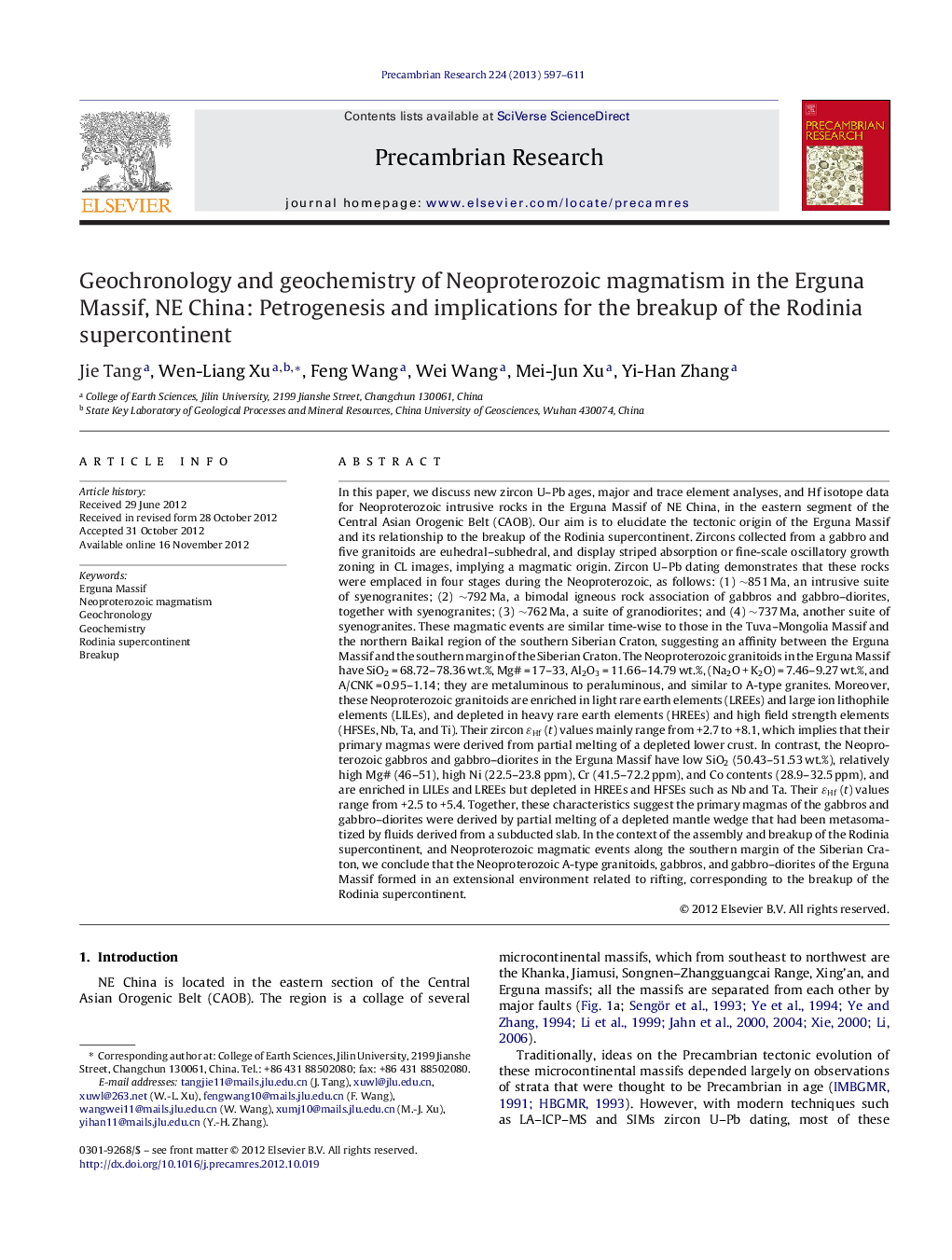| کد مقاله | کد نشریه | سال انتشار | مقاله انگلیسی | نسخه تمام متن |
|---|---|---|---|---|
| 4723365 | 1639650 | 2013 | 15 صفحه PDF | دانلود رایگان |

In this paper, we discuss new zircon U–Pb ages, major and trace element analyses, and Hf isotope data for Neoproterozoic intrusive rocks in the Erguna Massif of NE China, in the eastern segment of the Central Asian Orogenic Belt (CAOB). Our aim is to elucidate the tectonic origin of the Erguna Massif and its relationship to the breakup of the Rodinia supercontinent. Zircons collected from a gabbro and five granitoids are euhedral–subhedral, and display striped absorption or fine-scale oscillatory growth zoning in CL images, implying a magmatic origin. Zircon U–Pb dating demonstrates that these rocks were emplaced in four stages during the Neoproterozoic, as follows: (1) ∼851 Ma, an intrusive suite of syenogranites; (2) ∼792 Ma, a bimodal igneous rock association of gabbros and gabbro–diorites, together with syenogranites; (3) ∼762 Ma, a suite of granodiorites; and (4) ∼737 Ma, another suite of syenogranites. These magmatic events are similar time-wise to those in the Tuva–Mongolia Massif and the northern Baikal region of the southern Siberian Craton, suggesting an affinity between the Erguna Massif and the southern margin of the Siberian Craton. The Neoproterozoic granitoids in the Erguna Massif have SiO2 = 68.72–78.36 wt.%, Mg# = 17–33, Al2O3 = 11.66–14.79 wt.%, (Na2O + K2O) = 7.46–9.27 wt.%, and A/CNK = 0.95–1.14; they are metaluminous to peraluminous, and similar to A-type granites. Moreover, these Neoproterozoic granitoids are enriched in light rare earth elements (LREEs) and large ion lithophile elements (LILEs), and depleted in heavy rare earth elements (HREEs) and high field strength elements (HFSEs, Nb, Ta, and Ti). Their zircon ɛHf (t) values mainly range from +2.7 to +8.1, which implies that their primary magmas were derived from partial melting of a depleted lower crust. In contrast, the Neoproterozoic gabbros and gabbro–diorites in the Erguna Massif have low SiO2 (50.43–51.53 wt.%), relatively high Mg# (46–51), high Ni (22.5–23.8 ppm), Cr (41.5–72.2 ppm), and Co contents (28.9–32.5 ppm), and are enriched in LILEs and LREEs but depleted in HREEs and HFSEs such as Nb and Ta. Their ɛHf (t) values range from +2.5 to +5.4. Together, these characteristics suggest the primary magmas of the gabbros and gabbro–diorites were derived by partial melting of a depleted mantle wedge that had been metasomatized by fluids derived from a subducted slab. In the context of the assembly and breakup of the Rodinia supercontinent, and Neoproterozoic magmatic events along the southern margin of the Siberian Craton, we conclude that the Neoproterozoic A-type granitoids, gabbros, and gabbro–diorites of the Erguna Massif formed in an extensional environment related to rifting, corresponding to the breakup of the Rodinia supercontinent.
► The Neoproterozoic magmatisms are determined in the Erguna Massif, NE China.
► The Neoproterozoic magmatisms can be subdivided into four stages: ∼851, ∼792, ∼762, and ∼737 Ma.
► The Neoproterozoic magmatisms consist mainly of A-type granites and bimodal igneous rocks.
► The Neoproterozoic magmatisms reveal an extensional environment linked to the breakup of Rodinia.
Journal: Precambrian Research - Volume 224, January 2013, Pages 597–611